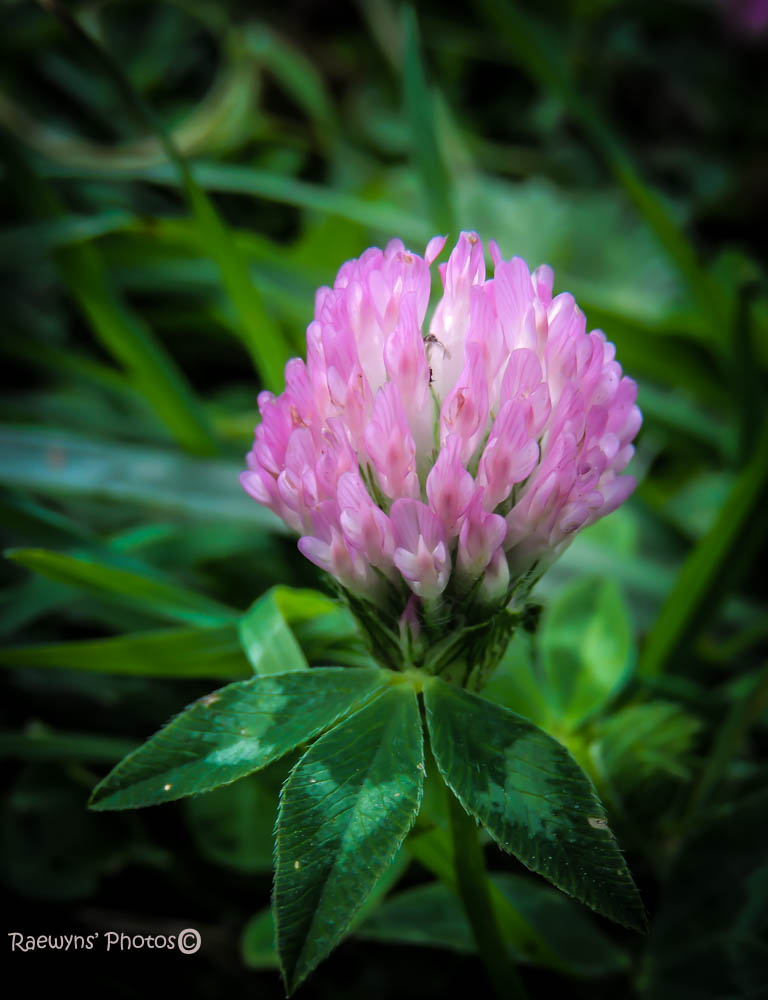Going through my photos I realised that I have focused on roses and leaves. That is because we have a couple of public rose gardens and of course our autumn has been totally awesome – so colourful and the leaves just begs for photos.
But then I found this lone clover which I had taken at Pakowhai Park. It is mostly used as fodder for farming but it is still a lovely flower. I won’t go into all the boring cultivation information though.
Clover or trefoil is a genus (Trifolium, Latin, tres “three”+folium “leaf”) of about 300 species of plants in the leguminous pea familyFabaceae. The genus has a cosmopolitan distribution; the highest diversity is found in the temperate Northern Hemisphere, but many species also occur in South America and Africa, including at high altitudes on mountains in the tropics. They are small annual, biennial, or short-lived perennial herbaceous plants. The leaves are trifoliate (rarely quatrefoiled, cinquefoil, or septfoil), with stipules adnate to the leaf-stalk, and heads or dense spikes of small red, purple, white, or yellow flowers; the small, few-seeded pods are enclosed in the calyx. Other closely related genera often called clovers include Melilotus (sweet clover) and Medicago (alfalfa or ‘cavalry clover’).
What I didn’t realise is that this flower is part of the pea family. So you learn something new every day.
Then there is the symbolism attached to it.
Symbolism
Shamrock, the traditional Irish symbol, which according to legend was coined by Saint Patrick for the Holy Trinity, is commonly associated with clover, though sometimes with Oxalis species, which are also trifoliate (i.e., they have three leaves).
Clovers occasionally have leaves with four leaflets, instead of the usual three. These four-leaf clovers, like other rarities, are considered lucky. Clovers can also have five, six, or more leaves, but these are rarer. The record for most leaves is 56, set on 10 May 2009.[4] This beat the 21-leaf clover,[5] a record set in June 2008 by the same man, who had also held the prior Guinness World Record of 18.[6]
A common idiom is “to be (live) in clover”, meaning to live a carefree life of ease, comfort, or prosperity. This originally referred to the fact that clover is fattening to cattle.[7]
The cloverleaf interchange is named for the resemblance to the leaves of a (four-leafed) clover when viewed from the air.
I will have to go out now to search for a four leaf clover then.
Thanks for visiting.





Beautiful! I’ve never seen it.
LikeLike
A very pretty plant portrait. Clover is such a great plant for bees.
LikeLike
I have learned something new today! A lovely flower!
LikeLike
I’ve seen it once. You have made it look so delicate and soft without making it blurred of course. Beautifully edited too.
LikeLike
Thanks so much. I am surprised that no-one seems to know this plant. It is common where I live
LikeLike
Then you should probable introduce more of us to it 😀
LikeLike
I thought it was just a common weed. lol
LikeLike
I say it is a beauty that deserves to be featured on your blog more than once 😀
LikeLike
I must find some more – in particular the 4 leaf variety to bring me some luck
LikeLiked by 1 person
When you find it, please mail it to me 😀
LikeLiked by 1 person
I will dedicate a post to you. How is that?
LikeLike
😀 that sounds very, very flattering and I would be beside myself from joy and honoured 🙂
LikeLiked by 1 person
There’s quite a lot of it over here–so much, in fact, that it’s usually taken for granted. It’s always good to get up close for a better look at an old friend!
LikeLike
Thanks so much for visiting. I just thought about how we see these fodder plants when in fact they are wildflowers.
LikeLike
We get fields of clover this time of year, including giant clover which looks exactly the same, but is (as you might guess) huge. Technically, it’s all weeds, but I love the wildflowers and protect them. The bees love them and use it to make honey and the cows adore it and munch it in their pastures.
LikeLike
They can be seen as wildflowers in the meadows. They do provide a lot of nutrients for the livestock.
LikeLike
Just wonderful. So dainty, and beautiful.
LikeLike
Thanks Gigi
LikeLike